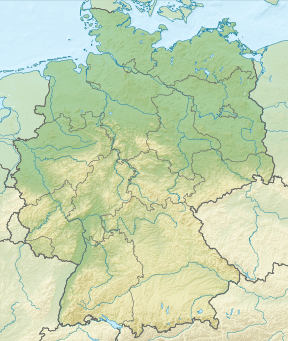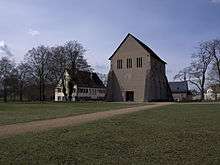Lorsch Abbey
Lorsch Abbey, otherwise the Imperial Abbey of Lorsch (German: Reichsabtei Lorsch; Latin: Laureshamense Monasterium or Laurissa), is a former Imperial abbey in Lorsch, Germany, about 10 km (6.2 mi) east of Worms. It was one of the most renowned monasteries of the Carolingian Empire. Even in its ruined state, its remains are among the most important pre-Romanesque–Carolingian style buildings in Germany. Its chronicle, entered in the Lorscher Codex compiled in the 1170s (now in the state archive at Würzburg), is a fundamental document for early medieval German history. Another famous document from the monastic library is the Codex Aureus of Lorsch. In 1991 the ruined abbey was listed as a UNESCO World Heritage Site.[1]
| UNESCO World Heritage Site | |
|---|---|
 The 9th-century Torhalle (gatehouse) is a unique survival of the Carolingian era. It curiously combines some elements of the Roman triumphal arch (arch-shaped passageways, half-columns) with the vernacular Teutonic heritage (baseless triangles of the blind arcade, polychromatic masonry). | |
| Location | Lorsch, Bergstraße, Hesse, Germany |
| Part of | Abbey and Altenmünster of Lorsch |
| Criteria | Cultural: (iii), (iv) |
| Reference | 515bis-001 |
| Inscription | 1991 (15th session) |
| Area | 3.11 ha (7.7 acres) |
| Buffer zone | 14.825 ha (36.63 acres) |
| Website | www |
| Coordinates | 49°39′13″N 8°34′11″E |
 Location of Lorsch Abbey in Hesse  Lorsch Abbey (Germany) | |
Imperial Abbey of Lorsch Reichsabtei Lorsch | |||||||||
|---|---|---|---|---|---|---|---|---|---|
| 852–1232 | |||||||||
 Coat of arms
| |||||||||
| Status | Imperial Abbey | ||||||||
| Capital | Lorsch Abbey | ||||||||
| Government | Theocracy | ||||||||
| Historical era | Middle Ages | ||||||||
• Founded by Count Cancor | 764 | ||||||||
• Codex Aureus produced | 778–820 852 | ||||||||
• Immediacy confirmed | 852 | ||||||||
• Gorze Reforms | 10th century | ||||||||
• Lorsch codex produced | 1175–95 | ||||||||
| 1232 | |||||||||
1679–97 | |||||||||
| |||||||||
| Today part of | |||||||||
Historic names
The following historical names have been recorded:
- In the 8th century: Laurisham[2]
- In the 9th century: Lorishaim
- 9th and 11th centuries: Loresham
- 9th–10th centuries: Laurishaim
- 10th century: Laresham
- 10th–12th centuries: Lareshaeim and Lauresheim
- 11th–12th centuries: Lauresham
- 11th century: Larsem, Loraszam, Lorozam, Lorisham
- 12th century: Laurisca, Laurisham, Laureshan, Loressam, Lorisheym, Lorscheim, Lors
History

Founding
The abbey was founded in 764 by the Frankish Count Cancor and his widowed mother Williswinda as a proprietary church (Eigenkirche) and monastery on their estate, Laurissa. It was dedicated to Saint Peter and Saint Paul. The founders entrusted its government to Cancor's nephew Chrodegang, Archbishop of Metz, who became its first abbot. The pious founders enriched the new abbey by further donations. To make the abbey popular as a shrine and a place of pilgrimage, Chrodegang obtained from Pope Paul I the body of Saint Nazarius, martyred at Rome with three companions under Diocletian. [3]
On 11 July 765, the sacred relics arrived, and with great solemnity were deposited in the basilica of the monastery. In 766 Chrodegang resigned the office of abbot, in favour of his other duties as Archbishop of Metz. He then sent his brother Gundeland to Lorsch as his successor, with fourteen Benedictine monks.
That same year, there was a dispute about property rights between Gundeland and Cancor's son, and the abbey was moved to an Ice Age dune, a few hundred metres from its original location on a small island in the Weschnitz. In 772, Gundeland applied to the highest authority, Charlemagne, who found in his favour. Gundeland gave the abbey with all his properties to the king, turning it into a Royal abbey.[3]
The abbey and basilica were then renamed in honour of Saint Nazarius: the main church of Saints Peter, Paul, and Nazarius was consecrated by the Archbishop of Mainz in September 774, in the presence of Charlemagne.
Influence
Many miracles were said to be wrought through the intercession of Saint Nazarius at Lorsch, and from all parts of Europe pilgrims in large numbers came to visit the shrine. In the course of the 9th century the library and scriptorium of Lorsch made it one of the cultural centres of Germany; its four surviving 9th-century catalogues show that it was rich in both Classical and Christian texts.[4] Few Carolingian manuscripts are better known than the Lorsch gospels, the Codex Aureus of Lorsch, now divided between the Vatican Library and the Batthyaneum Library in Alba Iulia, Romania; the carved ivory consular diptychs of Anastasius (consul 517) that were reused for its bindings are urbane classicising works of art in themselves, and embodiments of the classical tradition of Byzantium as it was transmitted to Lorsch in the time of Charlemagne.[5]
In 876, shortly after the death of Ludwig der Deutsche (Louis the German), the abbey became the burial place for the first "German" king. His son, Ludwig der Jüngere (Louis the Younger, died 882), and his grandson Hugo (died 879) were also buried at Lorsch. The burial chapel (ecclesia varia) later continued to serve as a Royal burial ground, e.g. for Kunigunde (died after 915), wife of the first non-Carolingean king, Konrad I (Conrad I).[3]
Popes and emperors repeatedly favoured the abbey with privileges and estates ranging from the Alps to the North Sea, so that in a short time it became not only immensely rich, but also a seat of political influence. It was declared a Reichsabtei (a sovereign principality in its own right, subject directly and solely to the emperor).
From 895-956, the abbey was not allowed to elect its own abbots: they were appointed by the king. Emperor Otto I restored this right to Lorsch. A confrontation between ruler and abbot about the construction of the castle of Starkenburg within view of the abbey resulted in abbot Udalrich confronting the king at Trebur with 1,200 armed riders. By 1090, Lorsch had been visited by kings/emperors around 20 times. In 1052, Pope Leo IX came to consecrate an altar in the burial chapel of the eastern Carolingeans.[3]
The abbey, enjoying sovereign territorial rights, became implicated in several local feuds and in a number of wars. After 46 Benedictine abbots had governed the abbey, Conrad, the last of them, was deposed by Pope Gregory IX in 1226, and through the influence of Friedrich II (Frederick II), Lorsch came into the possession of Siegfried III, Archbishop of Mainz, in 1232, ending the period of Lorsch's cultural and political independence.
From 1232 to 1248 Lorsch was used by the Cistercians.[3]
Later history
In 1248 Premonstratensian canons from Allerheiligen Abbey were given charge of the monastery with the sanction of Pope Celestine IV. In 1461, the abbey was mortgaged to the Electoral Palatinate. In 1556, Elector Palatine Otto Heinrich implemented the Protestant Reformation in his territories and dissolved the monasteries.
He removed the contents of the library to Heidelberg, forming the famous Bibliotheca Palatina, just prior to Lorsch's dissolution in 1557/1563. The remaining members of the abbey's religious community were pensioned off and sent away. In 1623, after the capture of Heidelberg, the Elector Maximilian of Bavaria presented the renowned library, 196 cases of manuscripts, to Pope Gregory XV.[6] Leo Allatius was sent to superintend its removal to Rome, where it was incorporated into the Vatican library as the "Biblioteca Palatina".
Destruction of the abbey
During the Thirty Years' War Lorsch and its neighbourhood suffered greatly. In 1621, Spanish troops pillaged the abbey and most of the buildings at Lorsch were pulled down. After the Archbishopric of Mainz regained possession of it in 1623, the region was returned to the Catholic faith. However, the abbey remained a ruin and served as a source of building materials for the whole region.[3]
The most depressed period for Lorsch was during the wars of Louis XIV of France in the late 17th century. Whole villages in the region were laid in ruins, the homes of the peasantry were burned, and the French soldiers torched the old abbey buildings. One portion, which was left intact, served as a tobacco warehouse in the years before World War I. The ancient entrance hall, the Königshalle or aula regia ("king's hall"; illustration above), built in the 9th century by King Louis II,[7] the oldest largely intact monument of Carolingian architecture.
See also
- Carolingian art
- Carolingian dynasty
- Carolingian Renaissance
Notes
- Abbey and Altenmünster of Lorsch on the UNESCO Register of World Heritage Sites
- Baron Sloet, L. A. J. W. (1872). Oorkondenboek der Graafschappen Gelre en Zutfen tot op den Slag van Woeringen, 5 Juni 1288. s'Gravenhage: Martinus Nijhoff. pp. 10 (no. 9).
- Schefers, Hermann. "History & Relevance of Lorsch Abbey". Kloster Lorsch. Retrieved 15 December 2018.
- James W. Thompson, The Medieval Library (New York) 1957, pp. 80-82; Chauncey E. Finch, "Catalogues and Other Manuscripts from Lorsch" Transactions and Proceedings of the American Philological Association 99 (1968) pp. 165-179.
- Margaret H. Longhurst and Charles Rufus Morey, "The Covers of the Lorsch Gospels", Speculum 3.1 (January 1928:64-74); Charles Rufus Morey, " The Covers of the Lorsch Gospels", Speculum 4.4 (October 1929):411-429).
- Thompson 1957; Finch 1968:165.
- Schefers, Hermann. "Gate Hall or Königshalle (King's Hall)". Kloster Lorsch. Retrieved 17 December 2018.
References

External links
| Wikimedia Commons has media related to Abbey and Altenmünster of Lorsch. |
- Abbey and Altenmünster of Lorsch: UNESCO Official Website
- Lorsch Abbey: official website (in English)
- Codex Laureshamensis, volume 1–3 Charters of Lorsch Abbey in Latin at Austrian Literature Online edited by Karl Glöckner, Darmstadt, 1929-1936.
- Interactive map of the property of Lorsch Abbey at Regnum Francorum Online
- Bibliotheca Laureshamensis – digital: virtualization of the monastic library of Lorsch Abbey
